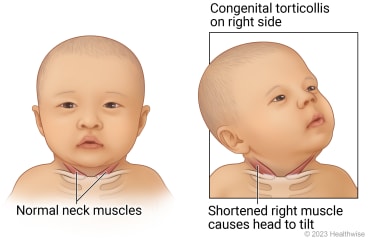Overview

Congenital torticollis is a problem your baby was born with. It means your baby's head is tilted. The chin points to one shoulder, and the back of the head tilts toward the other shoulder. It happens because a neck muscle is shortened. The cause is unknown, but it could be related to your baby's position in the uterus or during labor.
You may notice a lump in your baby's neck muscle. The lump usually goes away on its own. You may also notice that your baby wants to turn their head to one side over the other.
Your baby needs treatment from a physical therapist. The physical therapist will teach you stretches to do with your baby at home. Stretching helps give your baby better movement of the head and neck. This helps your baby's face and skull grow evenly. The physical therapist can also treat other developmental delays your baby may have. Other treatments may include a special helmet and possibly surgery.
Torticollis is also called wryneck.
Follow-up care is a key part of your child's treatment and safety. Be sure to make and go to all appointments, and call your doctor if your child is having problems. It's also a good idea to know your child's test results and keep a list of the medicines your child takes.
How can you care for your child at home?
- Stretch your baby's tight neck muscle several times a day. Your doctor or a physical therapist will show you how to do this. In general:
- Put your baby on their back on a changing table or a carpeted floor.
- If your baby's head is tilted to the right, gently tilt your baby's left ear toward the left shoulder. The chin points toward the right shoulder.
- If your baby's head is tilted to the left, gently tilt your baby's right ear toward the right shoulder. The chin points toward the left shoulder.
- Do things so that your baby turns their chin toward the correct shoulder.
- During feeding, hold your baby in a way that makes your baby turn the chin to the correct position.
- Place your baby in the crib or changing table so that the chin is turned the correct way in order to see the room.
- Place toys and other objects in such a way that your baby turns their head to see and play with those things.
- Lay your baby on their stomach on a firm surface. This is known as "tummy time." This position helps your baby learn to lift their head. Do this 2 or 3 times a day for a few minutes each time. This strengthens and stretches your baby's neck muscles.
- Sing songs or place toys in certain places to get your baby to turn their head in the correct position.
- Make sure you watch your baby during tummy time. Don't leave your baby unattended when in this position.
- Limit time spent in baby seats such as car seats and bouncy seats. Too much time spent in these can make the symptoms of torticollis worse.
When should you call for help?
Watch closely for changes in your child's health, and be sure to contact your doctor if:
- Your child's reaction to the stretching you do at home prevents you from doing it.
- Your child does not get better as expected.
Where can you learn more?
Go to http://www.healthwise.net/patientEd
Enter X965 in the search box to learn more about "Congenital Torticollis in Children: Care Instructions".
Current as of: July 24, 2025
Author: Ignite Healthwise, LLC Staff
Clinical Review Board
All Ignite Healthwise, LLC education is reviewed by a team that includes physicians, nurses, advanced practitioners, registered dieticians, and other healthcare professionals.

